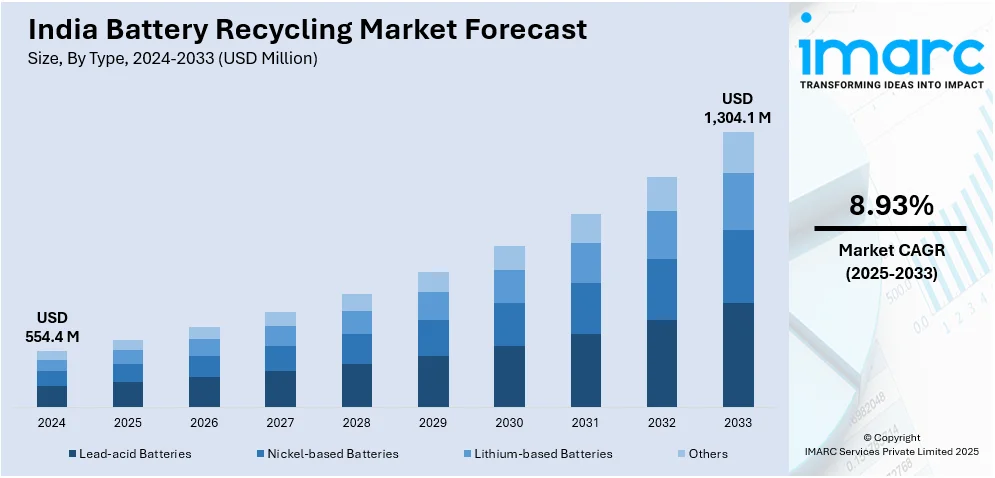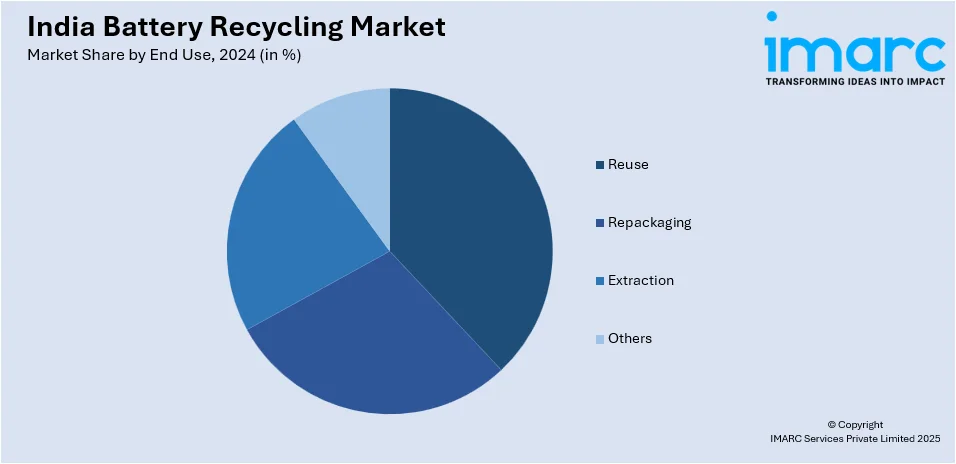
India Battery Recycling Market Size, Share, Trends and Forecast by Type, Source, End Use, Material, and Region, 2025-2033
Market Overview:
India battery recycling market size reached USD 554.4 Million in 2024. Looking forward, IMARC Group expects the market to reach USD 1,304.1 Million by 2033, exhibiting a growth rate (CAGR) of 8.93% during 2025-2033. The increasing advancements in recycling technologies, which make it more cost-effective and efficient to recover materials from batteries, are driving the market.
|
Report Attribute
|
Key Statistics
|
|---|---|
|
Base Year
|
2024 |
|
Forecast Years
|
2025-2033
|
|
Historical Years
|
2019-2024
|
| Market Size in 2024 | USD 554.4 Million |
| Market Forecast in 2033 | USD 1,304.1 Million |
| Market Growth Rate (2025-2033) | 8.93% |
Battery recycling is the process of recovering valuable materials from used batteries to prevent environmental pollution and conserve resources. Batteries contain hazardous materials such as lead, mercury, and cadmium, which can pose serious environmental and health risks if improperly disposed of. Recycling involves collecting, sorting, and processing used batteries to extract metals like nickel, cobalt, and lithium, which can be reused in the manufacturing of new batteries. This not only reduces the demand for raw materials but also minimizes the environmental impact of mining and extraction. Additionally, proper battery recycling helps prevent the release of harmful chemicals into soil and water, promoting a sustainable and eco-friendly approach to managing electronic waste. It is a crucial step in the responsible disposal of batteries to mitigate pollution and promote the circular economy.

To get more information on this market, Request Sample
India Battery Recycling Market Trends:
The battery recycling market in India is experiencing robust growth, primarily driven by a confluence of factors that underscore the increasing regional emphasis on sustainable practices. Firstly, heightened awareness regarding environmental conservation has propelled governments and businesses alike to adopt stringent regulations, necessitating the responsible disposal of batteries. Consequently, this has created a burgeoning demand for recycling services. Moreover, the rising adoption of electric vehicles (EVs) and renewable energy storage solutions has exponentially increased the volume of spent batteries, amplifying the urgency for efficient recycling mechanisms. In addition, advancements in technology have led to the development of more efficient and cost-effective battery recycling processes, further fueling market growth. Furthermore, the escalating demand for raw materials, such as lithium, cobalt, and nickel, essential components of modern batteries, has driven industries to explore recycling avenues as a sustainable source, contributing to circular economy principles. Collaborative initiatives between governments, manufacturers, and environmental organizations have also played a pivotal role in shaping the battery recycling market. In conclusion, the intertwining forces of environmental consciousness, technological progress, resource scarcity, and regulatory frameworks are propelling the regional battery recycling market forward on a trajectory of sustained expansion.
India Battery Recycling Market Segmentation:
IMARC Group provides an analysis of the key trends in each segment of the market, along with forecasts at the country level for 2025-2033. Our report has categorized the market based on type, source, end use, and material.
Type Insights:
- Lead-acid Batteries
- Nickel-based Batteries
- Lithium-based Batteries
- Others
The report has provided a detailed breakup and analysis of the market based on the type. This includes lead-acid batteries, nickel-based batteries, lithium-based batteries, and others.
Source Insights:
- Industrial
- Automotive
- Consumer Products
- Electronic Appliances
- Others
A detailed breakup and analysis of the market based on the source have also been provided in the report. This includes industrial, automotive, consumer products, electronic appliances, and others.
End Use Insights:

- Reuse
- Repackaging
- Extraction
- Others
The report has provided a detailed breakup and analysis of the market based on the end use. This includes reuse, repackaging, extraction, and others.
Material Insights:
- Manganese
- Iron
- Lithium
- Nickel
- Cobalt
- Lead
- Aluminium
- Others
A detailed breakup and analysis of the market based on the material have also been provided in the report. This includes manganese, iron, lithium, nickel, cobalt, lead, aluminium, and others.
Regional Insights:
- North India
- West and Central India
- South India
- East and Northeast India
The report has also provided a comprehensive analysis of all the major regional markets, which include North India, West and Central India, South India, and East and Northeast India.
Competitive Landscape:
The market research report has also provided a comprehensive analysis of the competitive landscape in the market. Competitive analysis such as market structure, key player positioning, top winning strategies, competitive dashboard, and company evaluation quadrant has been covered in the report. Also, detailed profiles of all major companies have been provided.
India Battery Recycling Market Report Coverage:
| Report Features | Details |
|---|---|
| Base Year of the Analysis | 2024 |
| Historical Period | 2019-2024 |
| Forecast Period | 2025-2033 |
| Units | Million USD |
| Scope of the Report | Exploration of Historical Trends and Market Outlook, Industry Catalysts and Challenges, Segment-Wise Historical and Future Market Assessment:
|
| Types Covered | Lead-acid Batteries, Nickel-based Batteries, Lithium-based Batteries, Others |
| Sources Covered | Industrial, Automotive, Consumer Products, Electronic Appliances, Others |
| End Uses Covered | Reuse, Repackaging, Extraction, Others |
| Materials Covered | Manganese, Iron, Lithium, Nickel, Cobalt, Lead, Aluminium, Others |
| Regions Covered | North India, West and Central India, South India, East and Northeast India |
| Customization Scope | 10% Free Customization |
| Post-Sale Analyst Support | 10-12 Weeks |
| Delivery Format | PDF and Excel through Email (We can also provide the editable version of the report in PPT/Word format on special request) |
Key Benefits for Stakeholders:
- IMARC’s industry report offers a comprehensive quantitative analysis of various market segments, historical and current market trends, market forecasts, and dynamics of the India battery recycling market from 2019-2033.
- The research report provides the latest information on the market drivers, challenges, and opportunities in the India battery recycling market.
- Porter's five forces analysis assist stakeholders in assessing the impact of new entrants, competitive rivalry, supplier power, buyer power, and the threat of substitution. It helps stakeholders to analyze the level of competition within the India battery recycling industry and its attractiveness.
- Competitive landscape allows stakeholders to understand their competitive environment and provides an insight into the current positions of key players in the market.
Key Questions Answered in This Report
The battery recycling market in India was valued at USD 554.4 Million in 2024.
The India battery recycling market is projected to exhibit a CAGR of 8.93% during 2025-2033, reaching a value of USD 1,304.1 Million by 2033.
Key factors driving the India battery recycling market include rising demand for electric vehicles, environmental regulations, increasing awareness of sustainable waste management, scarcity of raw materials, and government initiatives promoting recycling infrastructure. These elements collectively support market growth and reduce reliance on virgin battery materials.
Need more help?
- Speak to our experienced analysts for insights on the current market scenarios.
- Include additional segments and countries to customize the report as per your requirement.
- Gain an unparalleled competitive advantage in your domain by understanding how to utilize the report and positively impacting your operations and revenue.
- For further assistance, please connect with our analysts.
 Request Customization
Request Customization
 Speak to an Analyst
Speak to an Analyst
 Request Brochure
Request Brochure
 Inquire Before Buying
Inquire Before Buying




.webp)




.webp)












